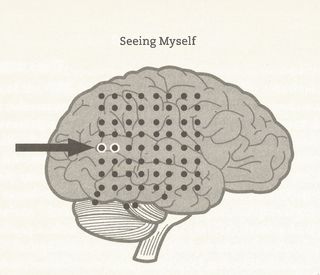Parapsychology
Out-of-Body Experiences: The Breakthrough
Part 7: The brain area that induces OBEs has been found.
Posted August 1, 2019
In 2002 the science of OBEs changed forever. By then I had long assumed I would never return to OBE research but this discovery dragged me straight back and is why I wrote the book, ‘Seeing Myself’ (Blackmore 2017).
In that year, a paper was published, not in an obscure fringe or paranormal journal, but in Nature, arguably the most prestigious science publication in the world. It declared: “The part of the brain that can induce out-of-body experiences has been located”.
The Swiss neurosurgeon, Olaf Blanke, and his team were operating on a 43-year-old woman who had been suffering from frequent epileptic fits for 11 years (Blanke et al 2002). Her condition would not respond to drugs and she could not be treated unless the site of the epileptic focus was found, that is the area of the brain where seizures begin and from where they spread to the rest of the brain. But the surgeons had failed to find the focus. As a last resort, they used an advanced technique that allowed them to stimulate, with great precision, many different places on the brain’s surface and then measure any resulting seizures. To do this they had to open up the skull and insert an array of subdural electrodes right on the surface of the brain. That means the electrodes are spread out underneath the dura; the tough outer membrane around the brain.
While tiny electrical currents were passed through selected parts of the array, the patient could remain awake because the brain has no pain receptors. This meant that she could answer questions and report what she experienced. As the surgeons stimulated different areas, they found many effects they would expect, including areas that produce particular sensations and others that cause muscle movements. They also managed to track down the seizure focus and remove it, leaving her free of seizures. What they did not expect was the woman’s reactions when they stimulated a spot on the right side of her brain.

With a gentle current she said she was “falling from a height” or “sinking into the bed”; her arms or legs seemed to move or change, and she felt very light. With a stronger current she said “I see myself lying in bed, from above”, and finally she had the sensation of floating near the ceiling above the bed, just as so many OBErs describe. Given our experience-based definition of the OBE, an OBE had indeed been induced.
The crucial spot was the temporoparietal junction, or TPJ, in the right hemisphere, where the temporal lobe and the parietal lobe meet.
There had been a few previous clues pointing to this part of the brain. Back in the 1930s, with much cruder technology, the pioneering Canadian neurosurgeon, Wilder Penfield, operated on epileptics when there was no other option. Using electrodes that were very crude by today’s standards, he once stimulated a patient’s right temporal lobe, and she cried out “Oh God! I am leaving my body” (Penfield 1955 p 458). Sadly, he was unable to investigate further. So it was not until Blanke’s discovery that the precise location could be found.

Further confirmation then followed when Belgian neurosurgeon, Dirk de Ridder, implanted electrodes in the brain of a 63-year-old man hoping to suppress long-lasting and intractable tinnitus (a continuous ringing or buzzing noise in the ear). Sadly, he failed to cure the tinnitus but when stimulating the patient’s right TPJ “An out-of-body experience was repeatedly elicited” (de Ridder 2007 p 1829).
Further evidence pointing to the TPJ came from damaged brains. It has long been known that people who report seeing doubles tend to have damage to the right parietal lobe, but this was only discovered by dissecting patients’ brains after death. By contrast, modern technology allows surgeons to find the site of the damage in living brains. In one study, Swiss researchers compared the precise location of brain damage in nine patients who reported OBEs and eight who did not. In eight out of the nine OBE patients the damage was in the right temporal and/or parietal cortex and most often at the TPJ (Ionta et al 2011).
An OBE has even been caught as it happened in a ten-year-old boy with epilepsy. The Swiss neuroscientist, Lukas Heydrich, measured the boy’s brain activity while he suffered a seizure in the hospital. The boy could tell the doctors when the seizure started because his left hand began to hurt and then began moving by itself. He asked his mother, “Look, the arm is moving. Who is moving the arm?”. After two minutes he became unconscious but later told the doctors that he had had a vivid sensation of being projected out of his physical body to hover just below the ceiling from where he could look down and see his mother and the room, though not his own body. Finally, he seemed to fly above the hospital and then even higher. “It feels like I am flying way above the world, but I know this can't be true. I feel light, very light!” (Heydrich et al 2011 p 584). The boy’s brain activity was measured throughout; the electroencephalogram suggested a focus in the right temporal lobe and an MRI scan revealed a lesion in the right angular gyrus – the same place that Blanke had identified before.
It seems there’s plenty of evidence to home in on the right TPJ, but what does it mean to have found this special place in the brain? In my next post, I will tackle this important question.
References
Blackmore, S. 2017 Seeing Myself: The new science of out-of-body experiences
Blanke, O., Ortigue, S., Landis, T. and Seeck, M. 2002 Stimulating illusory own-body perceptions. Nature, 419:269-70
De Ridder, D., Van Laere, K., Dupont, P., Menovsky, T., & Van de Heyning, P. 2007. Visualizing out-of-body experience in the brain. New England Journal of Medicine, 357(18), 1829-1833.
Heydrich, L., Lopez, C., Seeck, M., & Blanke, O. 2011. Partial and full own-body illusions of epileptic origin in a child with right temporoparietal epilepsy. Epilepsy & Behavior, 20(3), 583-586.
Ionta, S., Heydrich, L., Lenggenhager, B., Mouthon, M., Fornari, E., Chapuis, D., ... & Blanke, O. 2011. Multisensory mechanisms in temporo-parietal cortex support self-location and first-person perspective. Neuron, 70(2), 363-374.
Penfield, W. 1955. The twenty-ninth Maudsley lecture: the role of the temporal cortex in certain psychical phenomena. Journal of Mental Science, 101, 451-65


